Pregnancy week by week
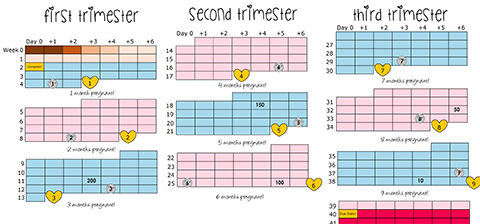 A pregnancy is generally measured in units called trimesters, divided into the three phases of pregnancy. These trimesters each last roughly 13 weeks, and a full term pregnancy is considered to be between 38 and 42 weeks long. Any baby born between these weeks is considered as an “on time” delivery.
A pregnancy is generally measured in units called trimesters, divided into the three phases of pregnancy. These trimesters each last roughly 13 weeks, and a full term pregnancy is considered to be between 38 and 42 weeks long. Any baby born between these weeks is considered as an “on time” delivery.
Although your doctor will give you a due date, keep in mind that this date is not carved in stone. Your baby could decide to enter the world two weeks before or two weeks after the predicted due date, and still be considered “full term”.
In some cases, your baby may be born even earlier, which is considered a premature birth. Depending on how early your baby arrives will determine the level of care required to bring your baby to a state of health. Many years ago, premature babies had little chance of survival. However, with today’s innovative technology, babies that weigh only a few ounces at birth fight to live, and they do.
Pregnancy calendar: week by week
Enter the date of the first day of your last menstrual period (LMP) and we’ll calculate a week-by-week timeline for you.
Here is a Week by week pregnancy calendar showing different stages of your body and baby development:
Pregnancy Calendar Week 1-13 (First Trimester)
| WEEK | YOU AND YOUR BODY | YOUR BABY |
| One | Sperm penetrates the egg, causing fertilization | Gender of the fetus is already determined |
| Two | Embryo has attached to the placental wall of the uterus | Embryo begins development, measuring a mere .006 of an inch long |
| Three | Early symptoms of pregnancy (morning sickness, breast tenderness, fatigue) begin | Central nervous system and cardiovascular system are developing, including blood cells and the heart |
| Four | No significant changes | Limbs begin to develop as small stumps, ears begin to form, and embryo now measures around .04 inches long |
| Five | Nausea may become more severe | Embryo’s head is the largest feature due to rapid brain growth, and the embryo is now between 2 and 3 inches long |
| Six | Breasts will start to enlarge and become more tender to touch | Fetus’ heart is now beating. An ultrasound or sonogram can detect the heart and tiny body although movement is not yet visible |
| Seven | No significant changes | Mouth, fingers, and toes are becoming more distinct, eyelids have formed, and movement is more detectable via ultrasound or sonogram |
| Eight | Sciatic nerve may cause some discomfort in the legs | Blood vessels are forming, fetus is taking on a more baby-like appearance with a rounded head and defined organs, and the fetus now measures 1 to 1.2 inches long, which is 10,000 times the size it was at conception |
| Nine | Waist will begin to thicken, and the uterus has grown to the size of a softball or grapefruit | Fetus has straightened, fingers and toes are quite defined, and movements, although small, can now be felt somewhat like small bubbles |
| Ten | Weight will continue to increase and some women will start to show while many still do not look pregnant to other people | Fetus now has very distinct human features and measures up to 1.5 inches in length |
| Eleven | Hair and nails generally become stronger because of prenatal vitamins and the uterus is swollen and starting to become visible | Major organs are formed and developing and the fetus is around 1.5 to 2.5 inches long.
At this point in the pregnancy, risks of genetic problems are greatly reduced. Typically, another sonogram will be performed. |
| Twelve | Weight gain is becoming noticeable for the first time, especially in your hips, and a dark line often develops down the abdomen, called Linea Nigra | Fetus’ chest rises and falls as though breathing as muscles learn how to work, heartbeat can easily be detected with ultrasound, and the fetus can suck its thumb and swallow |
| Thirteen | Stretch marks may appear on the abdomen, buttocks, and your breasts | Fetus now has organs that have taken over the production of blood cells, movement is occurring as the fetus flexes its muscles, bones and teeth are developed, and fetus measures up to 3 inches long |
Pregnancy Calendar Week 14-26 (Second Trimester)
| WEEK | YOU AND YOUR BODY | YOUR BABY |
| Fourteen | May develop moles, which you never had before or existing moles may increase in size | Fetus is continuing its growth process and now weighs around 1 pound |
| Fifteen | Fetus will begin to respond to stimulus, often moving when pressed against | Fetus is now covered with a fine coat of protective hair called Lanugo”, fetus can hear your heartbeat and the sounds of your stomach |
| Sixteen | Fetus will start moving more frequently | Depending on age or medical history, your doctor may recommend an Amniocentesis test to rule out certain abnormalities such as Down Syndrome |
| Seventeen | You will continue gaining weight, have a good level of energy, and continue to feel the fetus move | Fetus’ arms and legs are now developed, it can distinguish between salty and sweet tastes, is now weights around 6.5 ounces |
| Eighteen | Lower back pain and nasal congestion are common around this time | Fetus often develops hiccups that can easily be felt, starts responding to external noises, and weight is increasing rapidly, up to 8.6 ounces |
| Nineteen | Mild vertigo, or dizzy spells, is common. Stand up slowly and in addition to your six small meals, add a few snacks into your diet such as crackers or fresh fruit | Fetus now has milk teeth, additionally baby teeth are developing under the surface of the gums, and the fetus is approximately 10 ounces |
| Twenty | You have now reached the HALFWAY point! Itching on the abdomen and breasts will begin, due to the stretching of the skin | Fetus is covered with Vernix, which is a greasy coating that protects its skin from the amniotic fluid |
| Twenty-One | Swelling and discomfort are common in the hands, legs, and feet | Fetus continues growing with more and more movement |
| Twenty-Two | Food cravings begin, which is normal. However, if you experience bizarre cravings, it could be due to a mineral deficiency so be sure to talk to your doctor | Fetus’ weight gain starts to stabilize while the size continues to increase, head and body begin to come into more normal proportion |
| Twenty-Three | Early uterine contractions will occasionally occur | Sexual organs are now fully developed and more aggressive movement occurs |
| Twenty-Four | Fetus’ heartbeat can easily be detected and since your unborn baby can hear and recognize your voice, talk to it in a soothing tone | Sleep patterns start to be defined and the fetus now weighs over 1 pound |
| Twenty-Five | Rib pain, leg cramps, and headaches are common as the fetus takes up more uterine space cramping your organs and causing discomfort | Brain cell development is rapid, bones are losing softness, fetus is now inhaling and exhaling as it prepares for birth |
| Twenty-Six | May experience increased lower back pain as the fetus’ weight pulls on the spine, sit down and put your feet up whenever possible | If the fetus were to be born at this time, chance are it could survive at its current weight of 2 pounds, brain and lung continue to develop and a small amount of fat is now forming on the fetus |

Pregnancy Calendar Week 27-40 (Third Trimester)
| WEEK | YOU AND YOUR BODY | YOUR BABY |
| Twenty-Seven | Start prenatal classes in preparation for childbirth | Fetus’ eyes are open and blinking, can sense light and dark through your abdomen, and is usually sucking the thumb or hand |
| Twenty-Eight | Make arrangements for other children and/or pets | Although the lungs are still weak, fetus could easily survive if born at this time, and fetus now weighs around 2 pounds |
| Twenty-Nine | Check off your list for baby equipment and clothing to ensure you have everything needed | Eyebrows, hair, and eyelashes have grown in |
| Thirty | Not as much kicking due to limited space | Fetus is now consuming most of the uterine space and to get comfortable, will cross its arms and legs while drawing itself up |
| Thirty-One | Watch for warning signs of Preeclampsia | Brain is growing rapidly, fetus will respond to pain and touch, and the skin is starting to smooth out |
| Thirty-Two | You will feel the fetus turning and rolling rather than kicking as it positions itself for birth | Fetus has twisted itself head down in preparation for delivery and weighs around 3.5 pounds (if fetus has not positioned itself head down, this is a Breach birth and generally requires a C-Section birth) |
| Thirty-Three | Heartburn can be significant and if horribly uncomfortable, consult your doctor | Fingernails have formed, lungs are almost completely developed, and the fetus is now inhaling and exhaling at a regular rate |
| Thirty-Four | Although the fetus is still gaining weight, your weight gain has slowed down | If the fetus is a male, the testicles have dropped, fetus is responding more to outside stimulus, and the weight is up to 4.5 pounds |
| Thirty-Five | Mood swings, fear, and bouts of crying are typical | Fetus is now approaching 5 pounds |
| Thirty-Six | Total weight gain is generally between 25 and 30 pounds | Central nervous system is reaching full maturity and toenails are now complete |
| Thirty-Seven | Doctor will perform a pelvic examination to check on the position of the fetus | Lanugo (soft, protective hair) begins to diminish |
| Thirty-Eight | A sense of depression and being overwhelmed is common as hormones fluctuate and you will start to feel a tugging low in your abdomen as the fetus drops | Body fat has developed under the skin to protect and insulate the fetus and weight is now around 6.5 pounds |
| Thirty-Nine | Discomfort from the weight gain is now quite evident with increased lower back pain | If fetus is born now, it would be considered as a “full-term” baby |
| Forty | Contractions will be felt, intensifying, as you get closer to delivery. If contractions do not begin, your doctor may want to check the progress to include the thinning of the cervical wall and position of the fetus | Fetus is generally head down, knees pulled up to check, waiting to make its entrance |



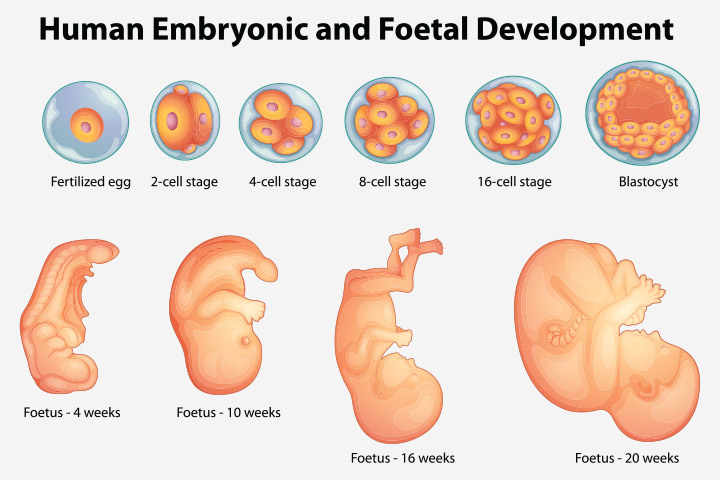
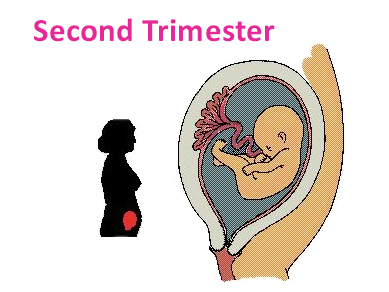
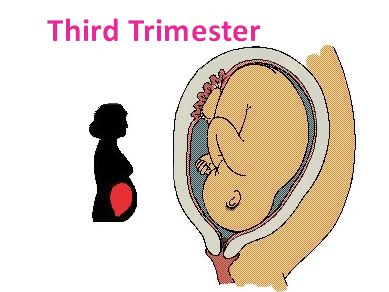
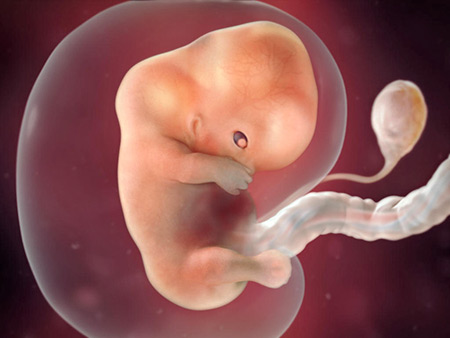
I really love the breakdown and explanation